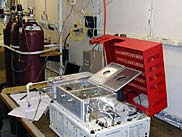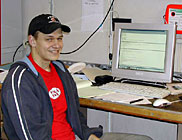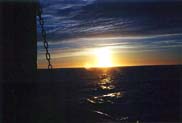|
|
|||||||||||||||||||||||||||||||||||||||||||||||||||||||||||||||||||||||||||||||||||||||||||||||||||
 |
|||||||||||||||||||||||||||||||||||||||||||||||||||||||||||||||||||||||||||||||||||||||||||||||||||
The journal entries thus far have done an excellent job depicting cruise life with one notable exception; they have not delved into the nocturnal life on the cruise. Well, my job is to run the gas chromatograph, and I am a creature of the night. But on a boat in the middle of the Atlantic Ocean, entertainment options are slightly more limited than in your typical neighborhood. So what goes on when we aren’t doing science? There are the obvious pastimes: a wide collection of DVDs and books goes a long way to passing the time. Card games are another favorite; four of the crew members have been playing an ongoing game of spades since the beginning of the cruise. People spend a fair amount of time writing and reading emails, our primary way of finding out what is happening outside our 250 ft. x 50 ft. world. On any other cruise, I would analyze water samples for hydrogen and methane only, but due to the unique geologic setting of the Lost City, Eric Olson and I developed an additional method on the GC that allows us to analyze the samples for higher molecular weight hydrocarbon compounds such as ethane and butane. Well, as you might imagine, determining the concentrations of so many different dissolved components can be quite time consuming, and the GC cannot be rushed. On days when Dave Butterfield’s fluid sampler goes down with Alvin, up to 14 different water samples can be collected that require gas chromatographic analysis, and this can make for some rather long, but very interesting, nights.
The nightlife in the Hydro Lab starts out not unlike a Saturday night on land owing mostly to the fact that I share the lab with the ABE team. Dress at Club Hydro is casual, the atmosphere is friendly, and Dr. D (Dana Yoerger) spins up some rockin’ tunes. The faces in the crowd are constantly changing as people drift in and out to watch the ABE guys do their thing. As the night wears on, the music dies down, and the crowd thins out until only myself and nocturnal ABE member Mike Jakuba remain. In the middle of the night the unending stream of chromatographic traces and Mike’s quiet typing across the way are like a hypnotist’s watch, and the night becomes almost surreal. On some nights during this heightened level of reality, I think I may have even been visited by Albert Einstein, who came offering assistance with my analyses, but I can’t be sure. Of course, not every night is so work intensive, and I use the slower nights to analyze the immense amount of data that is generated by the GC or, since I have the main lab pretty much all to myself, I may play loud music and practice dance moves from the 70's.
As you can see, the nights here can be every bit as busy as the days. However, The Lost City is remote and our time here is limited and expensive so round-the-clock operations are a must. At the end of the night when that last sample has been run, I sit back and content myself with fact that I know a whole lot more about the Lost City than I did just 12 hours ago. Then, when I realize that just about every scientist on board is generating huge data sets of his or her own, the vast amount of information that’s been gathered about this system in the 11 days that we’ve been here so far is mind numbing.
Finally, at around 5:30, when the sky begins to lighten and people once again begin to populate the ship, I know that it will soon be time for me to retreat to the darker corners of the ship and sleep, perchance to dream about gas chromatography, and rest up for the next night. Whether that night will bring a full load of samples and another heart-to-heart with Albert, or a chance to bone up on my Robot dance technique, you better believe it'll be a night to remember. |
|||||||||||||||||||||||||||||||||||||||||||||||||||||||||||||||||||||||||||||||||||||||||||||||||||



